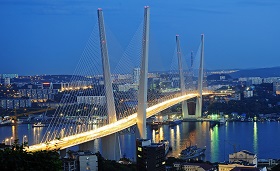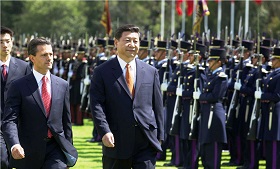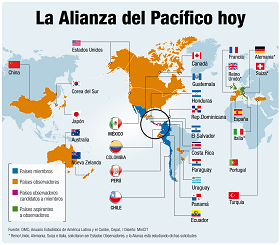Russia and Mexico in Asia Pacific
President Enrique Pena Nieto
In
Login if you are already registered
(no votes) |
(0 votes) |
Ph.D. in Economics, RIAC Member
Mexico's geopolitical priorities are steadily shifting to deeper cooperation with countries in the APR, both on the bilateral level and within existing and emerging integration groups such as APEC, the Pacific Alliance and the Trans-Pacific Partnership. Russia has also been seeking new forms of interaction with this dynamically-developing region. However, opportunities for Russian-Mexican cooperation in the Asia Pacific region seem limited, due to the two countries’ frail ties both in the bilateral format and in regional organizations.
Mexico's geopolitical priorities are steadily shifting to deeper cooperation with countries in the Asia Pacific Region (APR), both on the bilateral level and within existing and emerging integration groups such as APEC, the Pacific Alliance and the Trans-Pacific Partnership. Russia has also been seeking new forms of interaction with this dynamically-developing region, and suggested a new agenda during its 2012 APEC presidency. However, opportunities for Russian-Mexican cooperation in the Asia Pacific region seem limited, due to the two countries’ frail ties both in the bilateral format and in regional organizations.
Mexico's Interests in Asia Pacific
Developing relations with the APR is a key element of Mexican foreign policy. It aims to alleviate the country’s dependence on the United States and boost national independence and importance in the global arena. Mexico was the first Latin American state to join APEC (in 1993) but still fails to fully exploit multilateral dialogue, preferring to develop bilateral relations with Asian states.
Since the early 2000s, Mexican exports to countries in East and South-East Asia have been on the rise, increasing from 1.5 percent in 2000 to 3.7 percent in 2012. During the same period, China became Mexico's third largest export market after the United States and Canada. Imports from the Asia Pacific region are growing even faster, accounting for over 25 percent of Mexico's total imports. At the same time, Mexican leaders are not completely happy with the quality of these trade links, primarily with China, due to the huge trade deficit, incessant restrictions imposed on Mexican exporters under antidumping measures and huge volumes of illicit trade. The situation is aggravated by the long-standing competition between Mexico and China on U.S. markets.
This new vector of Mexican trade policy found reflection in President Peña Nieto's visits to Japan and China. Before setting off, he wrote a policy article outlining his country’s cooperation priorities with Beijing: trade, investment, tourism and culture. Mexico is working hard to reduce the excessive trade deficit with the PRC, i.e. USD 46.3 billion in 2011. China, for its part, seems ready to make bilateral trade more balanced and even to conclude a free trade agreement.
This new vector of Mexican trade policy found reflection in President Peña Nieto's visits to Japan and China. Before setting off, he wrote a policy article outlining his country’s cooperation priorities with Beijing.
Mexico needs Chinese capital because of the diminishing flow of foreign direct investment [1]. At the same time, the Nieto government depicts Mexico as the ideal platform to access the U.S. market. During several reciprocal visits, the parties have been negotiating construction of automobile assembly plants in northern Mexico’s maquiladoras, i.e. manufacturing operations in free trade zones. Mexico is also mulling the participation of Chinese oil companies in developing the country’s hydrocarbon resources as part of the planned energy sector reform. In June 2013, a preliminary agreement was reached about Mexican oil and gas supplies to the PRC that should finance construction of the infrastructure needed in the states of Veracruz and Oaxaca. Mexico is also looking to get a chunk of the growing flow of Chinese tourism, that Beijing expects will rise to 400 million trips over the next five years.
Mexico is also boosting economic cooperation with Japan. Apart from expanded access for Mexican goods to Japan under additional protocols to the bilateral free trade agreement, Japanese companies, primarily automakers, are stepping up their investment in Mexico, i.e. up to USD 3.5 billion for construction and an expansion of assembly facilities. Investment is on the rise both due to an increase in Mexican exports and to the effects of the 2005 Agreement on Economic Partnership. Along with the United States and the EU, Japan is a key provider of technology to Mexico.
Against the backdrop of advancing bilateral relations, interaction is expanding within the two new integration associations: the Pacific Alliance and the Trans-Pacific Partnership (TPP).
The Pacific Alliance was established in 2012 by Peru, Chile, Colombia and Mexico with Costa Rica joining in May 2013. Nineteen states in the Asia Pacific region and Europe have associated membership status. The group is geared at cooperation with the APR, and has established that creating a platform for further integration is one of its key missions. Many analysts believe that the bloc forms a counterweight to the integration initiatives of Brazil, i.e. UNASUR, making the Pacific Alliance extremely important for Mexico geopolitically as is it competes with Brazil for regional leadership [2].
In 2012, Mexico joined the TPP negotiations, largely because of Washington’s insistence (the U.S. regards the new alliance as a tool of its foreign trade strategy in Asia Pacific). The TPP provides for complete integration in trade, investment, competition policies, labor legislation, ecology, etc. The rigid non-preferential format of integration as promoted by the United States is deeper than that of NAFTA, and may bring Mexico not only new market opportunities but also fierce rivalry with more efficient Asian economies. In addition, Mexico will have to cede certain non-tariff restrictions and open its energy sector to foreign investors [3]. At the same time, joining the TPP seems inevitable, since the country would otherwise lose existing preferences in the U.S. market.
The Pacific Alliance was established in 2012 by Peru, Chile, Colombia and Mexico with Costa Rica joining in May 2013. Nineteen states in the Asia Pacific region and Europe have associated membership status.
Accession to the TPP should be in Mexico’s interests for two reasons. First, since the 1990s, the country has been committed to the principles of open regionalism and trade liberalization, which to a great extent define the similarity between Mexican and U.S. priorities in foreign trade. Mexico is extremely experienced in trade talks and has entered into free trade agreements with numerous Asia Pacific countries (five FTAs as of 2013). Second, the TPP should offer Mexico more opportunities to promote its goods in advanced APR countries’ markets.
Beijing's participation in the TPP is likely to annoy Mexico, as China will gain more opportunities to enter not only its but also U.S consumer markets, potentially ousting Mexican goods. However, Washington, the bloc's leader, is in no hurry to let China in, primarily for political reasons, despite a formal offer to join on rigid terms intentionally created so that they would be deemed unacceptable in Beijing. China, meanwhile, banks on developing isolated forms of regionalism in East Asia (ASEAN+6) [4], but there is still no clear vision of compatibility for these two opposing forms of regionalism. The absence of clarity about China’s accession to the TPP could give Mexico a temporary advantage vis-à-vis China in access to the Asia Pacific markets.
Russia's Interests in Asia Pacific
Russia is striving to expand its economic and political presence in the dynamic region and lend additional impetus momentum to the economic development of Siberia and its Far East. In the 2000s, Moscow attempted to boost bilateral relations with countries in the Asia Pacific region through participation in regional associations including APEC (since 1998), East Asia Summit (since 2011), ASEAN Regional Forum, etc.
Russia's economic presence in Asia Pacific is relatively modest, with its share of total APEC exports standing at less than six percent, giving Moscow only a minor role in the construction of regional mechanisms for economic cooperation. At the same time, Russia is a major nuclear power and a permanent member of the UN Security Council able to significantly influence cooperation in political and security matters.
Russia's approach to Asia Pacific integration is notable for the way it maneuvers between the isolated regionalism promoted by China and some South-East Asian states and the open regionalism of the United States, Japan and Australia. Moscow tends to avoid isolated regional forums hosted under Beijing's auspices (for example ASEAN+6) where it stands slim chance of becoming a full-fledged participant. At the same time, Russia wants to develop a strategic partnership with China, which is a major market for Russian energy, although open forms of regionalism, where it could theoretically play a proactive and independent role, do not always match its national foreign trade priorities regarding investment and trade liberalization. Moscow prefers to hold negotiations with third countries on behalf of the Customs Union of Belarus, Kazakhstan and Russia. In addition, tough requirements regarding liberalization of trade and investment contradict Russian laws, chiefly on access to strategic sectors for foreign capital.
Russia's approach to Asia Pacific integration is notable for the way it maneuvers between the isolated regionalism promoted by China and some South-East Asian states and the open regionalism of the United States, Japan and Australia.
Russia's priorities in the Asia Pacific Region chiefly lie in cooperation on energy, infrastructure and security rather than in trade liberalization. A major priority is building up oil, gas and coal deliveries (primarily to China, Japan and Republic of Korea) and electricity (to North-East Asia). Russia also wants to form a multilateral regional energy dialogue to effectively protect the interests of supplying countries. Non-hydrocarbon energy production, i.e. nuclear, is also relevant as Russia can supply equipment and construction capacity.
As far as development of infrastructure is concerned, Russia has an interest in promoting cargo traffic, including transit, through is Far Eastern ports and main railway lines, i.e. the Trans-Siberian and Baikal-Amur tracks. Infrastructure cooperation with North-East Asian countries (Trans-Korean Main Railway and Trans-Korean Gas Pipeline projects) seems particularly promising [5].
On food security, Russia would like to build up its produce exports to Asia Pacific, which has a fast-growing population, and is taking steps to complete the appropriate port facilities. The prospects for producing biofuel from grain and industrial crops traditional in Russia also seem good, including joint ventures with foreign participation [6].
Outlook for Russia-Mexico Cooperation in Asia Pacific

Russia’s Guiding Landmarks in the Asia-Pacific
after the APEC Summit in Vladivostok
Due to the limited volume of bilateral trade and investment , interaction between the two countries in Asia Pacific remains limited, with regional interplay existing only on the APEC platform. At the same time, common interests exist.
In the energy field, Mexico is Russia's rival in oil and gas supplies. However, both countries need effective mechanisms for a regional energy dialogue and to protect suppliers' interests. Mexico has expressed interest in Russian hydrocarbon production technologies and the construction of a gas transportation infrastructure. With two nuclear reactors and advocating green growth and measures to counter climate change, Mexico could ally itself with Russia in the promotion of safe nuclear technologies in the region. The two countries could also exchange technologies and knowledge on developing biofuel production.
Russia would find it helpful to establish cooperation with Mexican security agencies to counter narcotics production and trafficking. Russia's Federal Narcotics Control Service has been interacting with its Nicaraguan counterparts, including in operations against Mexican drug cartels. Data exchange and joint operations with Mexican security forces could further enhance the interdiction of drug deliveries to Russia.
In the energy field, Mexico is Russia's rival in oil and gas supplies. However, both countries need effective mechanisms for a regional energy dialogue and to protect suppliers' interests.
Tourism is a priority for Mexico, including in regional organizations and forums, and more and more Russians are going to Mexico. The Russian Far East and Siberia also seem attractive, especially for ecotourism, which could catch attention of Mexican vacationers provided suitable infrastructure is in place.
Prospects for broader bilateral cooperation in regional organizations are less promising. Russia does not seem very enthusiastic about joining the TPP talks, while the organization rules do not envisage observer status or associated membership. However, it seems rational for Moscow to seek observer status in the Pacific Alliance, with which Russia's trade stands at almost USD 1.5 billion, and the group is quite excited about expanding cooperation. In July 2013, Moscow hosted a presentation of the Pacific Alliance that expressed willingness to incorporate Russia as an observer.
The key opportunities for building economic and political cooperation between Russia and Mexico may be found in the bilateral field. But in order to step up its integration in Asia Pacific, Moscow may find it needs to attract Mexico as an ally and partner over a broad range of issues. Interaction between the two countries in Asia Pacific appears opportune in joint efforts to defend shared interests within regional forums and associations, and in the implementation of joint projects in the region in a wide variety of fields including: energy, tourism, infrastructure, and the agricultural sector.
1. CEPAL. La Inversión Extranjera Directa en América Latina y el Caribe. 2012. P. 263.
2. A.A.Lavut. Pacific Alliance of the Latin American Four // Latin America Journal 2012. № 4. P. 20.
3. Fergusson I.F., Cooper W.H., Jurenas R., Williams B.R. The Trans-Pacific Partnership Negotiations and Issues for Congress. Washington, DC: Congressional Research Service, 2013. P. 15.
4. S.V.Sevastyanov. Intergovernmental Organizations of East Asia: Evolution, Efficiency, Russian Participation. Dalnauka Publishers. 2008. P. 258.
5. Russia's Interests in Asia Pacific: Security and Development. Moscow. RIAC, Russian APEC Study Center. Prospect Publishers, 2012. P. 28.
6. Ibid. P. 17.
(no votes) |
(0 votes) |







